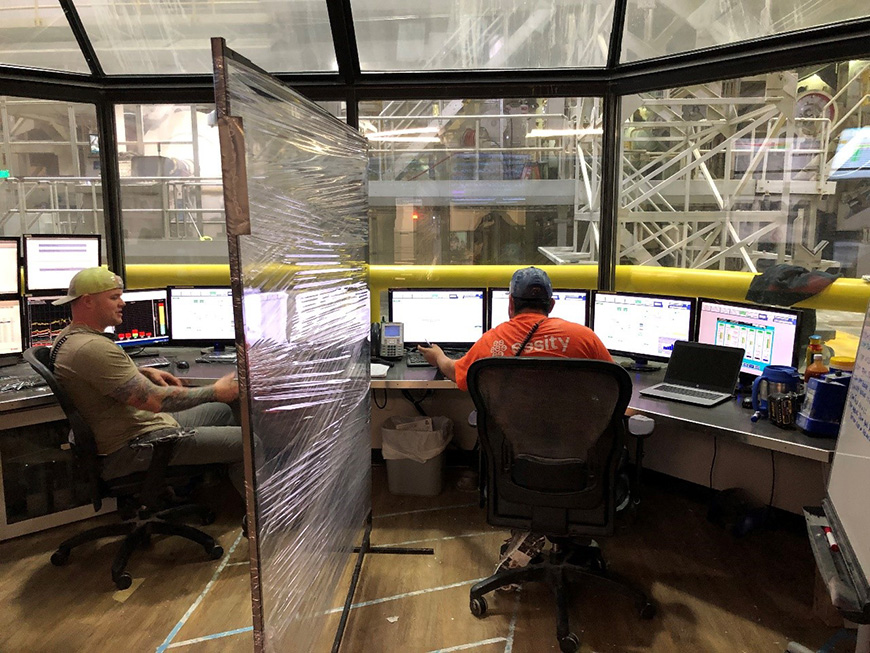How can manufacturers stay open and fully productive – while keeping employees safe at work – in the face of COVID-19? The challenge is unprecedented in modern industrial history as, for the first time, demand, supply, and workforce availability are all impacted simultaneously.1 Even with millions out of work due to the pandemic, that last factor, the availability of workers, is particularly problematic, as half of employees are worried that their health and safety will be endangered if they return to work onsite (according to research reported by Industry Week).2
The lessons learned by our own company, Essity, can provide a roadmap to help all manufacturers navigate the new normal.
Lesson #1: Set clear, employee-first priorities
In a global crisis, supply chains may be disrupted, demand may seem to evaporate, but none of that, no matter how daunting, is what needs to be dealt with first. The clear priority is your people and their safety, confidence and continued good health. That’s why Essity executed its plan with a bias always toward employees first.
And it paid off. As Jenny Turner, Marketing Director, Essity, Professional Hygiene, said, “The safety precautions we have taken in our facilities were introduced to protect and maintain the wellbeing of our employees. Implementing these strict protocols in our facilities has enabled our global operations to continue without disruption.” 3
To continue without disruption. That’s quite an accomplishment in these times – and to help other manufacturers do the same, Essity has published the Tork Safety Guide for Manufacturing.
This helpful guide spells out how to keep employee well-being front and center, by
- Establishing clear protocols and policies for everything from handwashing to what symptoms should keep employees’ home from work
- Providing sufficient PPE (consider deploying the specialized vending machines that can dispense PPE directly on the shop floor)
- Conducting training sessions on everything from hand hygiene to the proper taking on and off of PPE
- Being completely transparent about all efforts toward health and hygiene
- Maintaining constant communication about those efforts, for education and reassurance
Lesson #2: Create an atmosphere of calm
Investing in the last two points above, concerning the need for transparency and effective communication, will go a long way toward achieving the calm, confident state-of-mind required to keep workers on the job, focused and productive. For instance, the use of small signs, customized for your overall organization or specific departments, will help personalize the messaging, bring the importance of compliance closer to home, and remind workers at every turn that the company is actively working to keep them safe. Essity uses such signs and provides free online templates for you to create your own.

Your leadership team also plays a critical role in conveying a sense of calm and confidence. Are you requiring social distancing and the wearing of masks and/or face shields? Then all leaders, from the shop foreman to the CEO, need to consistently model the same behavior.
Lesson #3: Pursue a rigorous health and hygiene program 24/7
It is not enough, however, to simply communicate or even model consistency in healthy practices. Your plan needs to be comprehensive, rigorous, and executed without exception around the clock. Essity found that being able to continue operations without interruption, even as COVID-19 expanded, depended on effectively implementing protocols including:
- Strict social distancing. The now-common social rule of maintaining six feet of space between people applies on the factory floor or in office spaces, too. That may require the repositioning of machinery, equipment and desks, or, where that is not possible, the erection of barriers, such as clear-plastic dividers.

- Masks and other PPE. Face masks are recommended for all workers. Those who must frequently be closer than six feet from other workers should also use shields. And while gloves are sometimes called for, they do not replace handwashing, nor will they prevent workers from touching their faces and transmitting the virus in that manner.
- Controlled flow of people throughout your facility. Maintaining a proper distance can be a particular challenge as people move through production lines, hallways or in and out of common spaces like break rooms. Consider “directing” the flow of traffic, using measures such as specifying doors for entrance and exit, to avoid the need for co-workers to closely pass by each other.
- Heightened hand and respiratory hygiene. Encourage employees to frequently wash their hands for 40 seconds. Here again, signage explaining proper handwashing and the correct use of hand sanitizers can help. Also, placing hand sanitizing stations within reach of all employees will encourage their use, and help improve productivity by reducing unnecessary steps to use these supplies.
- Intensified cleaning. All surfaces need to be cleaned and disinfected at least once per shift, and more often for high-traffic areas. The cleaning solutions need to be examined to ensure they are capable of actually disinfecting a surface, as with solutions of at least 70% alcohol or those made with diluted bleach.
In addition to the work of cleaning and maintenance crews, individual employees need to be prompted to routinely disinfect commonly touched surfaces at the start and finish of every shift. These include HMIs (human and machine interfaces), keyboards, tables and chairs.
Download the guides to keeping industrial employees safe and factories operating
Through thorough planning, employee education and communication, and the strict adherence to in-depth cleaning protocols, Essity has been able to continue production throughout this crisis. The details of the organization’s learnings, and how other manufacturers can apply them, are provided in the Tork Site Safety Guide for Manufacturing. Download it here, along with Safe at Work: The COVID-19 Toolkit for Manufacturers.
Sources:
1 Industry Week: What will manufacturing’s new normal be after COVID-19?
2 Industry Week: 50% of US Employees Worry About Workplace Exposure to COVID-19
3 Essity: Tork site safety guide for manufacturing Essity
